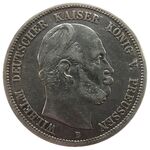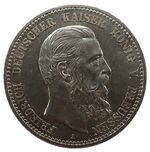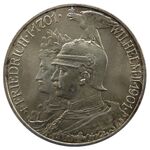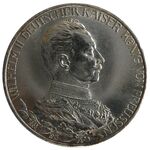
|
This article or section needs to be cleaned up to reach a higher standard of article quality.
Please follow the guidelines of our manual of style and complete this article to a higher level of quality. When this is done, this message may be removed. |
| 2 mark | |||
|---|---|---|---|
 
| |||
| Last general issue coin | |||
| General information | |||
| Country | |||
| Value |
ℳ2.00 | ||
| Years |
| ||
| Measurements and composition | |||
| Mass |
11.111 g[1] | ||
| Diameter |
28 mm[1] | ||
| Thickness |
2 mm[1] | ||
| Appearance | |||
| Shape |
round | ||
| Alignment |
medallic | ||
| Obverse |
| ||
| Reverse |
| ||
| v · d · e | |||
The 2 mark coin was first issued by the Kingdom of Prussia in 1876[8], during the reign of King William I.[9] This issue continued to be minted until 1884.[8] Following the death of William in 1888, Frederick III ascended to the throne, releasing a new 2 mark coin[8]. His reign was short-lived, as Frederick III died only 99 days later.[10] Later that year, another 2 mark coin was issued, which featured the kingdom's new leader, King Wilhelm II. The coin was issued in this manner until 1912.[8]
A commemorative coin 2 mark coin was issued in 1901, upon the 200th anniversary of the Kingdom of Prussia. Two others were minted in 1913, one in commemoration of the coalition victory at the Battle of Leipzig, and another for the 25th anniversary of Wilhelm II's reign.[8]
History[]
First coin[]

Coin of William I.
In 1876, the first Prussian 2 mark coin was introduced.[8] Its composition, mass, and measurements were equal to those of every other standard 2 mark coin circulating in the states of the German Empire at the time, being composed of .900 fine silver, weighing 11.111 grams, and measuring 28 millimeters in diameter and 2 millimeters in thickness.[1] A portrait of then-current Prussian king and kaiser of the German Empire, William I, was engraved on the coin's obverse, partially encircled by a legend reading "WILHELM DEUTSCHER KAISER KÖNIG V. PREUSSEN".[2] Underneath the image was either an "A", "B", or "C" mint mark, which indicated the coin was produced at the Berlin Mint, Hannover Mint, or Frankfurt Mint, respectively.[11] The Reichsadler of the Second Reich was featured on the coin's reverse, accompanied by the state title of the German Empire (DEUTSCHES REICH), the coin's value (as "ZWEI MARK"), and the year of minting. The coin was minted during the years 1876, 1877, 1879, 1880, 1883, and 1884. Between these years, a total of 29,823,787 of these coins were produced.[2]
Coin of Frederick III[]

1888 coin of Frederick.
In 1888, following the death of William I and the accession of Frederick III to the throne and kaiserdom, a new Prussian 2 mark coin was issued. The effigy of the previous king was replaced with one of Frederick, and the legend around the image now read "FRIEDRICH DEUTSCHER KAISER KÖNIG V. PREUSSEN". Unlike the previous series, this coin was only struck at the Berlin Mint, bearing an "A" mint mark underneath the portrait of Frederick III. Other than the mentioned alterations, no changes were made between the first and second issues. Because Frederick's reign lasted only 99 days, the coin was only minted in 1888. During this year, at least 50,000 coins of Frederick III were produced, with an unrecorded number being struck in proof quality.[3]
Coin of Wilhelm II[]
Reichsadler changes
| |

|

|
| 1874-1889 | 1890-1915 |
In 1888, shortly after the death of Frederick III, his son, Wilhelm II became King of Prussia and Kaiser of the German Empire. As a result, a new Prussian 2 mark coin was issued that year, which featured a portrait of the new king partially encircled by a legend reading "WILHELM II DEUTSCHER KAISER KÖNIG V. PREUSSEN". Underneath the image of Wilhelm was an "A". Production of Prussian 2 mark coins ceased in 1889, and then recommenced in 1891.[4][8] The obverse was not altered between the years, but the coin's reverse underwent a slight change. Throughout the German Empire, the Reichsadler had been been present on the reverses of all coinage since the gold mark was introduced in 1874. However, in 1890, the heraldic eagle was largened on coins struck throughout the Second Reich, including those of Prussia. Other than this minor change, no other alterations were made to the reverses of any German Imperial coins. The original composition, mass, and measurements of the first issues were retained with both issues of Wilhelm II. Prussian 2 mark coins featuring the new monarch were minted in 1888, from 1891 to 1893, during 1896, from 1898 to 1908, and then again from 1911 to 1912. Between all these years, at least 50,896,750 of these coins were produced, with an unrecorded number of proof coins being made between the years 1888, 1891, 1892, 1901, 1905, and 1906.[4]
1901 commemorative coin[]

1901 commemorative coin.
The Kingdom of Prussia was founded in 1701 by King (formerly Duke) Frederick I.[12] In 1901, 200 years after the kingdom was established, a Prussian 2 mark coin was minted to commemorate the event. An image displaying Wilhelm II wearing a Pickelhaube helmet in the foreground, and Frederick I in the midground, was engraved on the coin's obverse. The portraits of the two men were accompanied by a legend reading "FRIEDRICH • I • 1701 • WILHELM • II • 1901 •". Unlike the previous Prussian 2 mark coins, the 1901 commemorative issue did not carry a mint mark, but like most of the kingdom's gold mark coins, they were struck at the Berlin Mint. More than 2,600,000 of these coins were minted. The mintage of proof coins as not recorded.[6]
Commemorative Leipzig coin of 1913[]
1913 commemorative Leipzig coin
| |

|

|
| Obverse | Reverse |
The Battle of Leipzig was an armed encounter fought in 1813 during the War of the Sixth Coalition, between the coalition forces (which included Prussia) and the French Empire.[13] In 1913, a commemorative coin was minted to mark the 100th anniversary of the coalition victory against the French during the battle. The coin's obverse featured an eagle carrying a snake in its talons, accompanied by the state title of the German Empire, the year, and the coin's value. The reverse, unlike the previous Prussian 2 mark coins, did not display the Reichsadler. Instead, it featured a figure on horseback, likely Generalfeldmarschall Gebhard Leberecht von Blücher[14], surrounded by people. Above this engraving was a legend reading "DER KÖNIG RIEF UND ALLE ALLE KAMEN •", and below the image was another inscription, which read "MIT GOTT • FÜR KÖNIG UND VATERLAND 17 • 3 • 1813". At least 1,500,000 1913 Leipzig commemorative coins were produced. Proof examples are known to exist, but the exact mintage was not recorded.[7]
1913 commemorative coin of Wilhelm II[]

Commemorative coin of Wilhelm II.
By 1913, Wilhelm II had been in reign for 25 years. A Prussian 2 mark coin was minted during that year to commemorate this event. Its composition, mass, and dimensions were identical to all the 2 mark coins before it. A right-facing portrait of the kaiser, different from the one used on the most recent general issue 2 mark coin, was engraved on the coin's obverse. Directly underneath the effigy was an olive branch, and below the branch were the years "1888" and "1913", and the coin's mint mark (A). A legend reading "WILHELM II DEUTSHCER KAISER KÖNIG VON PREUSSEN" was inscribed around the coin's edge on the obverse. The reverse featured the large Reichsadler typical on all Imperial German coinage after 1889. A total of 2,000,000 of these coins were produced, with 5000 being struck in proof quality.[5]
Pattern coins[]
Throughout the 40 years of the Prussian 2 mark coin being minted, a number of patterns, coins minted but not circulated, were produced. The first of which was minted in 1875, during William I's reign. Examples were struck in silver and copper. The obverse was identical to that of the first circulated issue, but the reverse slightly differed. Unlike the coins that were actually circulated, the Reichsadler on the reverse was engraved within the center of a shield, with the heraldic eagle's crown floating above. The exact mintage of both compositions of the patterns is unknown, but in 2012, the silver coin in mint condition had an estimated value of $1500[15], while the copper coin in the same condition had an estimated value of $350.[16]
Other silver patterns were made in 1904, 1912, and 1913, and a nickel pattern was produced in 1909.[8]
Karl Goetz patterns[]
German medalist Karl Goetz engraved a Prussian 2 mark pattern coin in 1913. It was struck in silver, copper, silver-plated copper, and platinum. A left-facing portrait of Kaiser Wilhelm II was engraved in the center of the obverse, encircled by a legend reading "WILHELM II • DEVTSCHER • KAISER • KŒNIG V. PREVSSEN". A crowned eagle perched atop a small shielded Reichsadler was displayed on the coin's reverse. Above the eagle was the state title of the German Empire, and the shielded Reichsadler was flanked by the coin's "value" (inscribed as "2 MK") to the left, and the year of minting to the right.[8]
Notes and references[]
External links[]
| German gold mark | |
|---|---|
| Banknotes | 5 ℳ • 10 ℳ • 20 ℳ • 50 ℳ • 100 ℳ • 1000 ℳ |
| Coins | 1 ₰ • 2 ₰ • 5 ₰ • 10 ₰ • 20 ₰ • 25 ₰ • 50 ₰ • ½ ℳ • 1 ℳ • 2 ℳ • 3 ℳ • 5 ℳ • 10 ℳ • 20 ℳ |
| Miscellaneous | Bavarian Mint • Berlin State Mint • Coinage Act of 1873 • Darmstadt Mint • Dresden Mint • Frankfurt Mint • Hamburg Mint • Hannover Mint • Karlsruhe State Mint • Muldenhütten Mint • Reichsbank • Reichskassenschein • Stuttgart State Mint |
| 2 mark | Anhalt (Anhalt-Dessau) • Baden • Bavaria • Bremen • Hamburg • Hesse • Lippe • Lübeck • Mecklenburg-Schwerin • Mecklenburg-Strelitz • Oldenburg • Prussia • Reuss Elder Line (Reuss-Obergreiz) • Reuss Younger Line (Reuss-Schleiz) • Saxe-Altenburg • Saxe-Coburg-Gotha • Saxe-Meiningen • Saxe-Weimar-Eisenach • Saxony (Saxony-Albertine) • Schaumburg-Lippe • Schwarzburg-Rudolstadt • Schwarzburg-Sondershausen • Württemberg |
|---|---|
| 3 mark | Anhalt • Baden • Bavaria • Brunswick • Hamburg • Hesse • Lippe • Lübeck • Mecklenburg-Schwerin • Mecklenburg-Strelitz • Prussia • Reuss Elder Line • Saxe-Meiningen • Saxe-Weimar-Eisenach • Saxony • Schaumburg-Lippe • Schwarzburg-Sondershausen • Württemberg |
| 5 mark | Anhalt • Baden • Bavaria • Bremen • Brunswick • Hamburg • Hesse • Lübeck • Mecklenburg-Schwerin • Oldenburg • Prussia • Saxe-Altenburg • Saxe-Coburg-Gotha • Saxe-Meiningen • Saxe-Weimar-Eisenach • Saxony • Schaumburg-Lippe • Waldeck-Pyrmont • Württemberg |
| 10 mark | Anhalt • Baden • Bavaria • Bremen • Hamburg • Hesse • Lübeck • Mecklenburg-Schwerin • Mecklenburg-Strelitz • Oldenburg • Prussia • Reuss Younger Line • Saxe-Coburg-Gotha • Saxe-Meiningen • Saxony • Schwarzburg-Rudolstadt • Württemberg |
| 20 mark | Anhalt • Baden • Bavaria • Bremen • Brunswick • Hamburg • Hesse • Mecklenburg-Schwerin • Mecklenburg-Strelitz • Prussia • Reuss Elder Line • Reuss Younger Line • Saxe-Altenburg • Saxe-Coburg-Gotha • Saxe-Meiningen • Saxe-Weimar-Eisenach • Saxony • Schaumburg-Lippe • Schwarzburg-Sondershausen • Waldeck-Pyrmont • Württemberg |
Template:Prussian thaler
